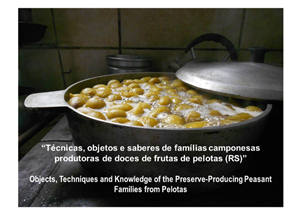Objects, Techniques and Knowledge of the Preserve-Producing Peasant Families from Pelotas
Keywords:
Tradition, Culture, Eating, Objects.Abstract
This photo essay presents some of the results of the research project Knowledge, Flavors and Images from the Colony, conducted by the Food and Culture Research and Study Group (GEPAC - https://www.ufrgs.br/gepac/), in partnership with the Laboratory of Agricultural and Environmental Studies (LEAA) and the Laboratory of Education, Research and Production in Anthropology of Image and Sound (LEPPAIS), associated to the Anthropology Graduate Program of the Federal University of Pelotas (PPGAnt/UFPel), with support from the Research Support Foundation of the State of Rio Grande do Sul (FAPERGS). The work is based on an ethnographic research conducted from January to March, 2016 along with peasant families that produce fruit preserves in the city of Pelotas, located in the southernmost portion of Rio Grande do Sul. The study of eating habits has been an approach and understanding material objects as an integral part of the social life.Using this methodology, we identified and recorded appliances and techniques belonging to the universe of the fruit preserve-making tradition of Pelota’s countryside. This tradition is associated to the production of preserves such as dried fruit, jams, spreads, compotes and candied fruit, produced mainly from fruits like fig, peach, orange, grape, banana, guava and others.
The artisan production of preserves is a tradition carried on by rural families with different ethnic backgrounds, particularly by descendants of German, French, Italian, Polish and Pomeranian immigrants who arrived in the region as of the mid-19th century. The production of fruit preserves is an activity that makes up the way of life of hundreds of rural families from the region, and it is largely carried out in domestic kitchens or small preserve factories. However, despite its historical, economic and cultural importance, the permanence of the artisan production of fruit preserves is at risk, given that the producing families are under pressure from health authorities to adjust the production to the standards laid down by law. In this scenario, the artisan making and the traditional household articles used to prepare preserves such as, for example, copper pans, wooden molds and wooden spoons are prohibited by the health legislation as they are not consistent with the logic of the major food industry players, thus becoming unfit for the activity and associated to production processes deemed as obsolete. The images show the presence of a preserve-making tradition punctuated by both industrial and artisan techniques and knowledge. In this scenario, many farmers keep on confronting the State, resisting the industrial production modes and reproducing an ancient know-how in the artisan production of preserves.
Credits:
Authors:Evander Eloi Krone (PPGA/UFPE) and Renata Menasche (PPGAnt/UFPel)
Photographs:Evander Eloi Krone
Direction, image editing and text: Evander Eloi Krone and Renata Menasche

Downloads
Published
Issue
Section
License

This work is licensed under a Creative Commons Attribution-NonCommercial 4.0 International License.
Direitos Autorais para trabalhos audiovisuais publicados na AntHropológicas Visual sã licenciados para uma licenca Creative Commons 4.0 BY-NC.
